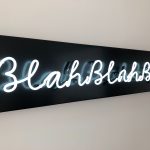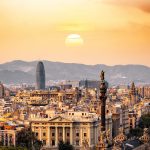For the latest in our Creative Conversations series, E&M visited Polish artist Michał Janowski at his home studio in east London. Janowski talks Brexit, his working methods and Eastern European roots.
E&M: Hi Michal, thank you for agreeing to chat with us and inviting us into your home studio. First of all, what you can you tell us about your home country?
Poland is a funny country. And it’s a very, ultra-Catholic country. I will put it very simply: in Poland, the Church is trying to control as much of the media as possible. We never really spilt from the Church, the way they did in England, so the Church has enormous power. It is involved in politics, especially.
E&M: And what does the younger generation make of the Church’s influence?
Young people in Poland are amazing. They are breaking through it. The internet: that’s how it started. My generation started with the internet so we were learning from Wikipedia instead of books. For people in countries where brainwashing is so hard, the internet is the only rescue.
E&M: What are your feelings towards Europe?
I love Europe. And I think the more exchange the better. Even in terms of food and music and culture. That’s what is really, incredibly interesting about it. Learning from each other and taking things from each other is great. Coming to Brexit, I was a little bit surprised. I lost a little bit of trust to England, I must say, because before I felt this was not a place for such irrational ideas.
E&M: What would be your ideal European city to exhibit in?
Budapest. I’m in love with Budapest. I’ve only known it a couple of years, which is probably why I’m so in love with it still. Its architecture is amazing. It feels like home but a bit of an upgraded home. It is upgraded, on many levels. The culture is amazing. I love the national gallery; I love Hungarian paintings. I think there will be a time when Hungarian paintings will be a lot more popular. They are colour snobs in Hungary. They are so snobbish about colour that you look at the paintings and, very often, you don’t know how they achieved that. Again, it’s eastern Europe, they are so, almost scientific with it. But there is a bit of a lack of freedom there.
E&M: What inspires your work and processes?
It’s a long process—building the language. Sometimes it starts in me and other time it develops on the surface where one shape suggests another. Like in jazz composition. You just need to keep collecting those fragments you are interested in—explore them. Often, we create at first and then we search for meaning. For example, the lack of the mouth, masks, subject of death, white painted skin, it’s all linked very much with my feelings. I paint my feelings. Then I found that it relates to Butoh, Native American folklore, Greek mythology, African traditions and so on. There must be a reason for it and all I can do is to proceed and learn. I know that my work appears quite primal, as those feelings are alive in me. I think primal fear is very much alive in all of us. Therefore, we seek so much comfort in life. Nowadays we understand that trauma and experience could be carried in our DNA. So, who knows what kind of luggage I have? Maybe I carry it around with me. I can’t guarantee it, but it interests me. There must be a reason for it.
E&M: Do the images you create come to you in dreams?
Some of the elements, yes. I’m not skilled enough to use them consciously. I think this is far more subconscious now and that’s why I’m interested in the process of Liminality. [Upon which the ‘Trickster’ series is based.] Trickster is a shaman of the Liminal. He is aware of the threshold and he can bring experience from the moment he left but not quite arrived. It reminds me of what Nick Cave said quite recently: ‘What happens when an event occurs that is so catastrophic that you just change? You change from the known person to an unknown person. So that when you look at yourself in the mirror, you recognize the person that you were, but the person inside the skin is a different person.’ I think there many events in our life that can shape us. They could be also positive as well. My son was born 10 months ago, I’m biologically transformed into a father, yet the mental understanding of this process requires everyday work. There are societies that still cultivate rituals—I think it is very interesting and could help some of us.
E&M: How has social media opened things up to you?
It is an extremely helpful tool. I can connect daily with collectors. And I can find them because I like the work they collect. So there is a chance that they might like my work. But also, I can find more artists I am interested in. I can follow their collections, which is not only for profit but also their work might influence me. You can expose yourself really well with social media. So you don’t really need galleries, that much. But, on the other hand, we are flooded with images. So there are new challenges for artists.
Featured image: top left: Michal Janowski, Trickster; Man With the Red Horn, mixed media on canvas, 102x76x4cm © Saatchi Art, top right: Michal Janowski, Philosophy of Nature Painting, acrylic on canvas, 60x60cm © Saatchi Art, bottom right: Michal Janowski, Shape Shfting as Favourite Method of Decepetion, paint on canvas, 102x76x4cm, © Saatchi Art










